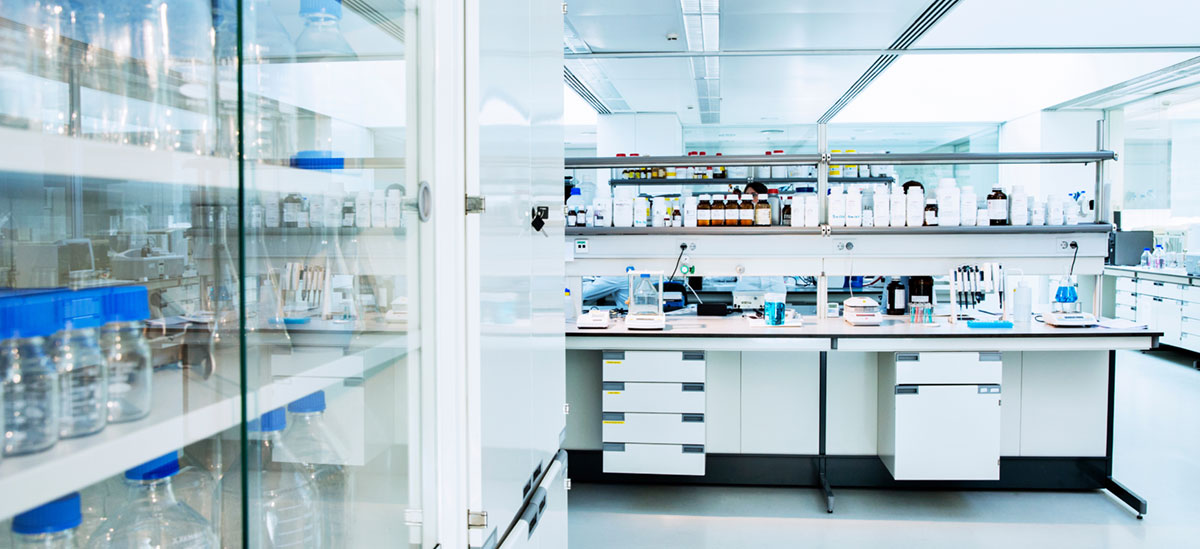Amniotic fluid (AF) is a uniquely rich biological material, containing hundreds of proteins that support fetal development and tissue repair. Recent studies confirm that cell-free, minimally processed AF retains a wide array of these regenerative components, including growth factors, cytokines, and extracellular matrix (ECM) proteins [1]. Preclinical literature has already demonstrated its value in promoting wound healing, reducing inflammation, and supporting immune modulation [2-3].
At Nova Vita Labs, we’ve built upon this foundation to assess how our proprietary AF processing method preserves and delivers this regenerative potential. Through quantitative proteomics, cytokine profiling, and functional cell-based assays, we evaluated the biological activity of acellular AF across multiple relevant human cell types. Our goal: to move beyond anecdote and demonstrate how these molecular components translate into real cellular effects.
Proteomic Groundwork: Over 700 Reasons for Regenerative Potential
We began by characterizing the full proteomic signature of the processed AF using LC-MS/MS. This analysis identified over 700 unique proteins, including growth factors, chemokines, ECM proteins, and signaling regulators. This level of diversity is a strength, as it reflects the biological complexity of AF and its role in coordinating multi-pathway developmental and reparative processes.
Among the most impactful bioactive molecules detected:
- FLT1 (VEGF receptor 1): Modulates endothelial migration and angiogenesis [4].
- IGF-2: Promotes tissue repair, cellular metabolism, and anti-apoptotic signaling [5].
- IL-1RA (IL1RN): A potent anti-inflammatory cytokine that inhibits IL-1 activity [6].
- IGFBP-3 and IGFBP-5: Control the availability and function of insulin-like growth factors [7].
- TGFBI and THBS1: Involved in TGF-β signaling and ECM remodeling [8].
Importantly, many of these molecules were confirmed not only by mass spectrometry but also through ELISA quantification, providing orthogonal validation of their presence and concentration.
Evaluating Functional Activity Across Regenerative Cell Types
We next examined the functional impact of AF on three primary human cell types integral to skin and hair regeneration:
• Human Epidermal Keratinocytes (HEKa)
• Hair Follicle Dermal Papilla Cells (HFDPC)
• Human Outer Root Sheath Cells (HORSC)
These cell types serve as relevant models for assessing cell migration, immune signaling, and structural regeneration.
Wound Closure in Dermal Papilla Cells
Dermal papilla cells regulate hair follicle cycling and play central roles in wound closure, angiogenesis, and ECM remodeling. They serve as an ideal model for evaluating AF’s influence on cellular migration and structural recovery. In scratch wound assays, HFDPC cultures treated with AF showed significantly faster gap closure compared to controls, with full closure occurring in many cases within 36 hours. These effects align with proteomic detection of angiogenic and proliferative drivers such as VEGF, IGF-2, and TGF-β cofactors, and suggest robust activation of the PI3K/Akt and MAPK/ERK pathways—both essential for wound healing [9].
Structural Remodeling in Follicular Sheath Cells
Outer root sheath cells support follicular structure and contribute to matrix organization and regeneration. To assess their structural response, HORSCs were cultured in 3D hydrogel matrices. AF-treated cultures formed denser, more cohesive spheroid structures, indicating enhanced ECM production and cellular organization. These effects are supported by upregulation of fibronectin, matrix metalloproteinases (MMPs), and integrin-mediated adhesion, consistent with activation of the TGF-β/Smad and focal adhesion kinase (FAK) pathways [10].
Cytokine Modulation and Inflammation Control
Epidermal keratinocytes are key to initiating wound repair, serving as frontline mediators of re-epithelialization and immune signaling. To evaluate AF’s influence on inflammatory modulation, cytokine profiles were assessed in HEKa and HFDPC cultures. Treatment led to:
• Downregulation of IL-6, MCP-1, and TNF-α
• Reduced secretion of CXCL1 and IL-8
These changes point to suppression of NF-κB and JAK/STAT pro-inflammatory signaling, likely mediated by IL-1RA and other anti-inflammatory factors present in the fluid. ELISA confirmed the presence of IL-1RA at biologically active concentrations [11].
Mapping the Pathways
Pathway enrichment analysis revealed upregulation of:
- PI3K/Akt (proliferation, survival, migration)
- TGF-β/Smad (ECM regulation, fibrosis control)
- MAPK/ERK (cell cycle, wound repair)
- Wnt/β-catenin (cell polarity, regeneration)
- IL-10 signaling (immune suppression)
These pathways were differentially activated across the three cell types but showed consistent modulation in support of regenerative activity.
This analysis also revealed important points of convergence between signaling pathways. For example, both PI3K/Akt and TGF-β/Smad pathways are known to influence cell survival, extracellular matrix remodeling, and migration—three key components of regenerative activity. When these pathways are simultaneously activated, the result may be a synergistic effect that amplifies repair mechanisms. This overlap suggests that amniotic fluid–derived products may not only trigger multiple processes in parallel but also enhance their combined impact within a regenerative microenvironment.
Why This Matters
While anecdotal outcomes drive much of the excitement in regenerative therapies, mechanistic validation is essential. These findings demonstrate that AF-derived products are not just composed of bioactive molecules, they activate regenerative signaling cascades in relevant human cells. Migration, ECM remodeling, cytokine suppression, and proliferation were all measurably enhanced in vitro, establishing functional relevance.
This positions AF as a unique, multifactorial therapeutic tool: not a single-target agent, but a matrix of signaling cues that work in concert to restore tissue homeostasis.
Staying Within Regulatory Scope
All testing described here was conducted in vitro under controlled laboratory conditions. The results are not intended to imply clinical efficacy or promote unapproved use. Our intent is to explore mechanisms of action and build a scientific foundation for further preclinical and clinical research, in alignment with 21 CFR Part 1271 and current FDA guidance.
Conclusion
Amniotic fluid is a naturally complex, regenerative medium. Through detailed proteomics and functional cellular assays, we’ve demonstrated that minimally processed AF retains and delivers that complexity in ways that measurably alter cell behavior. From enhanced wound closure and anti-inflammatory modulation to ECM restructuring, these effects were confirmed by both qualitative and quantitative analyses—reinforcing the product’s multi-pathway regenerative potential.
These data support the continued investigation of acellular AF-derived biologics and reinforce our commitment to rigorous, transparent science. To access the full dataset, including quantitative figures and methodology, contact us at info@novavitalabs.com.
References
[1] Underwood, M. A., et al. "Amniotic Fluid: Not Just Fetal Urine Anymore." Journal of Perinatology, vol. 25, no. 5, 2005, pp. 341–348. https://doi.org/10.1038/sj.jp.7211290.
[2] Koob, T. J., et al. "Biologic Properties of Dehydrated Human Amnion/Chorion Composite Graft." International Wound Journal, vol. 10, no. 5, 2013, pp. 493–500. https://doi.org/10.1111/j.1742-481X.2012.01019.x.
[3] Parthasarathy, A., et al. "Antimicrobial Properties of Amniotic and Chorionic Membranes." JCDR, vol. 7, no. 3, 2013, pp. 446–449. https://doi.org/10.7860/JCDR/2013/5086.2791.
[4] Ferrara, N., et al. "The Biology of VEGF and Its Receptors." Nature Medicine, vol. 9, no. 6, 2003, pp. 669–676. https://doi.org/10.1038/nm0603-669.
[5] Deak, M., et al. "Insulin-like Growth Factor II Stimulates Cell Growth via MAPK." JBC, vol. 275, no. 46, 2000, pp. 36317–36323. https://doi.org/10.1074/jbc.M006112200.
[6] Arend, W. P., et al. "Physiology and Pathophysiology of Interleukin-1." Rheumatic Disease Clinics, vol. 30, no. 3, 2004, pp. 437–463. https://doi.org/10.1016/j.rdc.2004.05.004.
[7] Firth, S. M., & Baxter, R. C. "Cellular Actions of the Insulin-like Growth Factor Binding Proteins." Endocrine Reviews, vol. 23, no. 6, 2002, pp. 824–854. https://doi.org/10.1210/er.2001-0033.
[8] Bork, P., et al. "Thrombospondin Type 1 Repeats: A New Protein Module." TIBS, vol. 21, no. 12, 1996, pp. 476–478. https://doi.org/10.1016/S0968-0004(96)10058-6.
[9] Broughton, G., et al. "The Basic Science of Wound Healing." PRS, vol. 117, no. 7S, 2006, pp. 12S–34S. https://doi.org/10.1097/01.prs.0000225430.42531.c2.
[10] Hinz, B., et al. "The Myofibroblast: One Function, Multiple Origins." Am J Pathol, vol. 170, no. 6, 2007, pp. 1807–1816. https://doi.org/10.2353/ajpath.2007.070112.
[11] Dinarello, C. A. "Overview of the IL-1 Family in Inflammation." Immunol Rev, vol. 281, no. 1, 2018, pp. 8–27. https://doi.org/10.1111/imr.12621.






